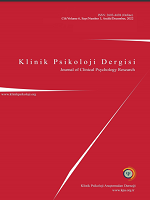Neuroimaging findings related to panic disorder: A brief review
Neuroimaging findings related to panic disorder: A brief review
Author(s): Dilara Kazancı, Seren Saltoğlu, Emel ErdoğduSubject(s): Neuropsychology, Clinical psychology, Health and medicine and law
Published by: Klinik Psikoloji Araştırmaları Derneği
Keywords: panic disorder; neuroimaging; fMRI; PET; EEG; fNIRS; anxiety;
Summary/Abstract: Panic disorder (PD) is defined by recurrent unanticipated panic attacks and anxiety of losing control, which negatively affects the patients’ quality of life. Various neuroimaging techniques allow to assess brain structure or function and therefore represent important tools to understand the mechanisms related to PD pathology. Current studies have highlighted neural differences between PD patients and healthy controls using MRI, PET, SPECT, or EEG. However, there is an urgent need to discuss findings from various investigations simultaneously in order to obtain a multidimensional understanding of PD pathology, which further allows identifying possible target regions for more effective treatment or prevention strategies. Therefore, the present work briefly reviewed PD related neuroimaging studies published between 2012 and 2021. Relevant articles were searched using a combination of keywords relevant to various neuroimaging techniques (e.g., MRI, MRS, PET, EEG, fNIRS) and to PD (e.g., panic, anxiety, panic disorder). Studies involving patients with comorbid conditions other than agoraphobia and participants aged under 18 were excluded. A total of 20 studies fulfilling inclusion criteria were considered in this review. Most of the reviewed studies point to structural and functional neural changes in regions of the proposed fear network mostly including the hippocampi, thalamic nuclei, amygdala, anterior cingulate corti, insulae and other frontal lobe regions. Such neural changes in PD are thought to result in a hypersensitive fear network affecting normal emotional processing. Finally, studies showed that different treatments can partly reverse these changes, which significantly improves the quality of life in PD patients.
Journal: Klinik Psikoloji Dergisi
- Issue Year: 6/2022
- Issue No: 3
- Page Range: 406-415
- Page Count: 10
- Language: English

